Streambank Revegetation and Protection: A Guide for Alaska
Introduction
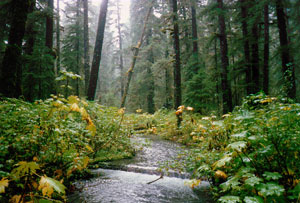
Healthy riparian systems function to the benefit of many species, the ecosystem, and are essential for sustainable populations. Although natural riparian areas make up a relatively small portion of the available landscape (<1%), they support an abundance of life and provide a significant amount of nutrients compared with adjacent upland areas. A stable vegetated bank also benefits the landowner and visitor by preventing land loss, providing natural beauty and promoting a healthy environment for sustainable fish and wildlife populations. Revegetation of riparian areas involves replanting native vegetation adjacent to lakes, streams, and creeks for the benefit of the species utilizing the system, watershed and associated uplands.
Different fish species require different in-water habitat features dependent on their life cycle
stage. Research has shown that riparian vegetation is
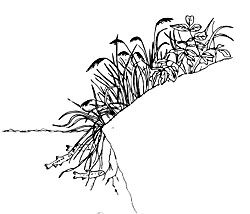 beneficial to salmonid species by providing
food, shelter, and shade that correspond with fish camouflage. Riparian vegetation influences
nearshore water temperatures, decreases nearshore stream velocities and provides resting places
for juvenile fish. Naturally occurring undercut banks and nearshore areas with large woody debris
are preferred habitat for certain juvenile salmonids when compared to rock rip-rap structures and
non-vegetative areas (Peters, 2004; Peters et al., 1996).
beneficial to salmonid species by providing
food, shelter, and shade that correspond with fish camouflage. Riparian vegetation influences
nearshore water temperatures, decreases nearshore stream velocities and provides resting places
for juvenile fish. Naturally occurring undercut banks and nearshore areas with large woody debris
are preferred habitat for certain juvenile salmonids when compared to rock rip-rap structures and
non-vegetative areas (Peters, 2004; Peters et al., 1996).
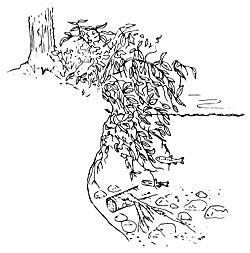
Juvenile chinook salmon primarily inhabit areas with water velocities between 0.09 and 0.6 ft/s and rarely use areas with velocities 2.1 ft/s or greater (Burger et al., 1982). This and other preference factors mean that in large rivers such as the Kenai River, an estimated 80% of the young chinook salmon are within 6 feet of the bank where water velocities are less than 1 ft/s (Hauser and Weiss, 2001; Liepitz, 1994; Burger et al., 1982). In a habitat selection study, it was found that juvenile chinook salmon utilized habitat with water velocities less than 20 cm/s, depths of 20-80 cm, and were closely associated with undercut banks (Hillman et al., 1987). Another study showed most salmonids studied (Dolly Varden, coho and chinook salmon) selecting focal point velocities between 0.0-0.9 cm/s and preferring large woody debris for cover (Dolloff and Reeves, 1990). Even a small change to juvenile salmon habitat water velocities and depth may decrease habitat values and salmon survival (Liepitz, 1994; Burger et al., 1982; Alaska Department of Natural Resources, 1986). Survival of early life stages of salmon is imperative to productive returns of adults.
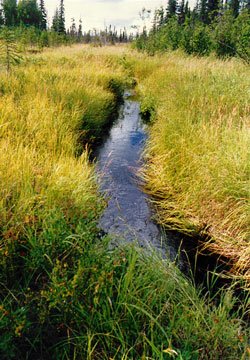
Potential benefits of vegetated buffers to wildlife include: increased species diversity, increased foraging sites, wildlife dispersal corridors, escape from flooding, hibernation sites, breeding and nesting sites, decreased disturbance, and decreased predation (Groffman et al., 1991). The habitat values of revegetation techniques far exceed the rock rip-rap, plastic, cement, metal or bulkhead alternatives. While the non-vegetative "bank stabilization" (rock rip-rap & bulkheads) projects may provide some bank protection, they also increase nearshore water velocities, provide little to no fish and wildlife cover, provide no living nutrient addition to the water column and do not simulate riparian functions. Addition of rock rip-rap to the riparian zone changes the sediment transport capacity and this in turn may cause movement outside the normal range of bed load size and particle distribution for a particular stream reach (Beschta and Platts, 1986). Since salmonids rely on diverse and particular particle sizes for food, cover and spawning, this may decrease their survival. As example, the densities of coho salmon, juvenile steelhead, and cutthroat trout declined following installation of rock rip-rap in four streams in western Washington (Knudsen and Dilley, 1987).
A native species revegetation project also has the advantage of requiring less maintenance over time once vegetation is established. The goals of these projects are to mimic natural vegetation and provide fish and wildlife habitat while reestablishing the functions of a riparian ecosystem. It is important to remember that native vegetated banks in riparian systems change over time with the ebb and flow of the aquatic systems they represent. Streambank stability is dependant on a healthy riparian and wetland system, which provides proper channel morphology, natural stream flow and good water quality. Deformable streambanks are therefore a consideration when discussing revegetation of riparian areas and recognition is necessary that lateral streambank erosion is a natural process that needs to occur for healthy ecosystems (Miller, 1999; Rosgen, 1994).
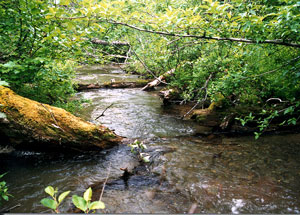
Riparian vegetation also provides bank protection and erosion control through water transpiration, tensile strength of roots, mechanical integrity of roots by forming arches and buttresses, and vegetation mats above the soil line that lock soils. Above ground, vegetation disperses rainfall and helps to prevent run-off by incorporating water into the soil and into the water column, decreases run-off velocity and water channelization and dissipates flow. A study comparing 748 river bends concluded that non-vegetated riparian bends were five times more likely than vegetated river bends to have undergone detectable erosion, and major bank erosion was thirty times more prevalent on non-vegetated bends than vegetated bends (Beeson and Doyle, 1995). Revegetation has been performed around the world for centuries as a cost effective water body protection measure, documented first in the 15th century in Europe. Since that time, revegetation techniques have proceeded to increase in acceptance and structural integrity.
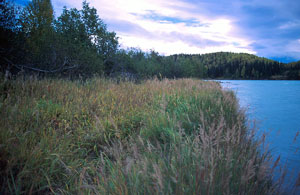
Many threats exist for our riparian areas with the increase in developmental and recreational access pressure to our creeks, lakes and rivers. Riparian vegetation is decreasing at an alarming rate in areas throughout Alaska. A decrease in riparian and wetland vegetation translates into a decrease in water quality, decrease in riparian functions and an increase in sedimentation of our water bodies. In fact, a compilation study confirms the importance of vegetated buffers, concluding that a 50m buffer is effective at removing approximately 75% or greater of the run-off sediment and certain pollutants, while providing only minimal general wildlife habitat. In contrast, a 600m water body buffer provides approximately 99% sediment and certain pollutant removal and excellent general wildlife value including supporting a diverse community and protection of significant species (Desbonnet et al., 1994). Increased suspended sediment into our water bodies may affect salmonids by covering spawning areas, decreasing feeding success, decreasing fertilization rates, decreasing growth rates, increasing displacement, and decreasing overall survival (Cook-Tabor, 1995). Soil particles may irritate fish gills potentially causing infection and death. Decreased water quality also endangers aquatic organisms, a major food chain component, which in turn has negative affects on higher levels of the food chain. Sedimentation prevents light from filtering through the water column, which lowers photosynthesis.
Some bank stabilization techniques do not involve revegetation with native species. This book specifically focuses on native species revegetation in riparian areas. We have decided to include some revegetation techniques, which may be utilized in upland and other wetland areas. Please note that all of these techniques should be used in consultation with a revegetation specialist with Alaskan plant species experience. Successful Alaskan streambank revegetation and protection projects have provided the foundation for this guide. As new streambank revegetation and protection challenges are met, this science will continue to evolve.
